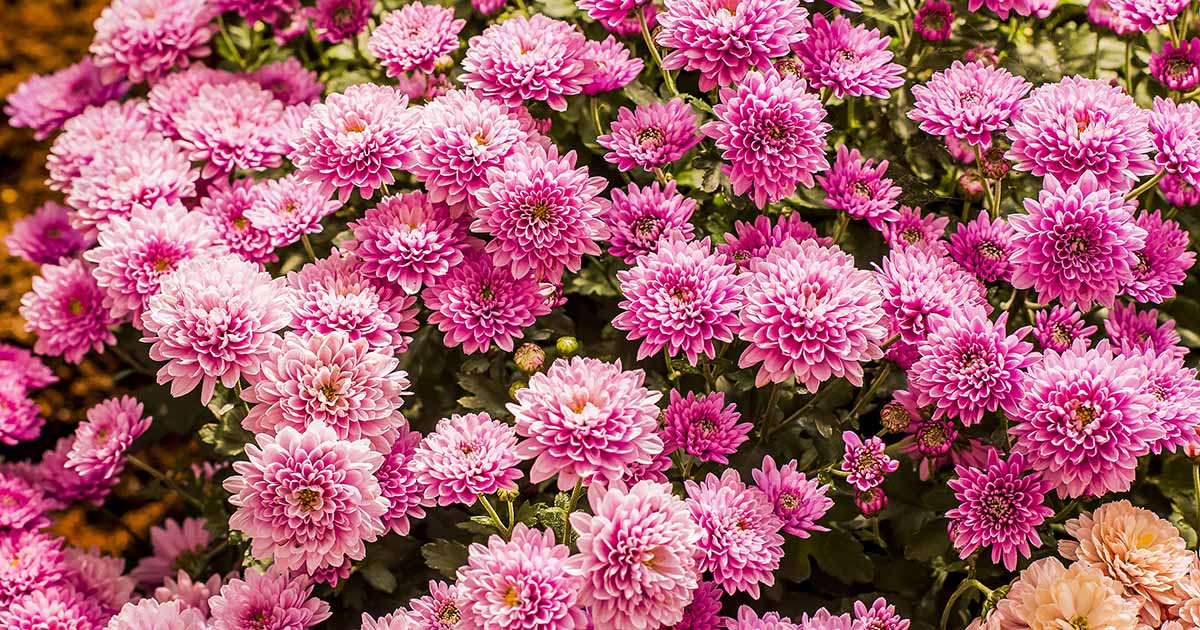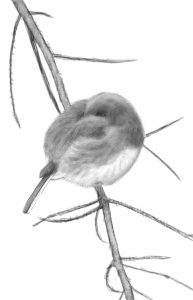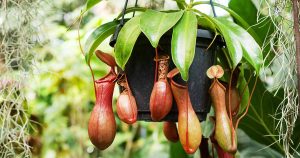
Chrysanthemums are beautiful and highly valued plants for the late season garden, creating gorgeous mounds of cheery, daisy-like flowers in a large array of colors.
They’re outstanding in beds, borders, and containers and are also a popular addition to fall decor schemes, adding easy color to harvest and cider-pressing parties, plus autumnal celebrations like Halloween and Thanksgiving.

We link to vendors to help you find relevant products. If you buy from one of our links, we may earn a commission.
Chrysanthemums have a long flowering time, blooming from late summer into late autumn, and regular pinching and providing optimal conditions can ensure a prolific display of blooms.
These cold hardy herbaceous perennials are generally low maintenance and easily cultivated, and if you’re not seeing masses of flowers, a few easy corrections can quickly restore their glory.
Is your garden ready for abundant, colorful cushions of chrysanthemum flowers? Then let’s get started and discuss the best tips for masses of blooms!
Here’s what you’ll find ahead:
Chrysanthemum Bloom Time: Tips for Abundant Flowering
1. Light Exposure
Although chrysanthemums can tolerate a bit of light shade, if they have to stretch for sunlight they tend to become leggy, taking on a loose form, with fewer stems for bud set.
And fewer buds naturally leads to fewer flowers.

Plus, the stems of chrysanthemums grown in shady locations are typically thinner and weaker, causing them to flop or break in heavy rain or wind, which also results in flower loss.
For strong plants with a thick, dense form and plenty of flower buds, give your chrysanthemums a full sun location, or at least six hours of direct sunlight each day.
Also, avoid placing your chrysanthemums where they receive light from artificial sources at night, such as landscape lights, porch lights, or streetlights.
Mums are short-day plants and unwanted light can cause a late bud set, resulting in fewer buds or none at all.
2. Moisture Levels
Maintaining adequate moisture levels in the soil is another important factor to promote a vibrant floral display.
Chrysanthemums are shallow rooted and don’t like to dry out between water applications – and enduring prolonged dry periods can be highly detrimental to bud set.

For a lush, vibrant bud set, keep the soil lightly moist, providing plants with one inch of water per week during the vegetative or early growing stage.
This means they also need well-draining soil to prevent standing water from collecting in the root zone, which can cause its own set of problems like root rot.
However, once the buds start to open, you may need to increase the frequency of watering to keep the soil evenly moist – don’t allow more than the top half an inch to dry out between applications.
If you’re unsure about determining moisture levels, a moisture meter takes away the guesswork.
During periods of high heat, more frequent – even daily – watering may be needed, particularly for container-grown chrysanthemums which tend to dry out quicker than those growing in the ground.
To help retain soil moisture and to keep the roots cool, you can apply a two- to four-inch layer of summer mulch over the root zone using materials such as bark, compost, leaf mold, or straw.
3. Rich Soil
One of the best ways to ensure healthy chrysanthemums that produce plenty of buds is to grow them in fertile, loamy soil – but it also needs to be well-draining.

When planting, enrich the soil with one or two parts of organic matter such as compost, well-rotted manure, or worm castings.
To help keep the soil evenly moist, add in one part of moisture retentive materials such as coconut coir, peat moss, perlite, or vermiculite.
And to improve drainage, mix in one part of grit, such as horticultural sand, pea gravel, or stone chips.
Giving your plants a fertile, well-draining location is one of the foundational building blocks to healthy plants. Start them out strong and they can’t help but to give back with an ample bud set!
You can find all the cultivation details in our chrysanthemum growing guide.
4. Fertilizer
Chrysanthemums aren’t heavy feeders, but they do benefit from regular fertilization to promote healthy roots, strong bud set, and overall vigorous growth.
An effective and easy fertilizing regime is to start feeding plants in early spring with a one- to two-inch layer of compost, well-rotted manure, or worm castings applied over the root zone.
A second application of compost can be made in midsummer after the buds set.
Or you can supplement the compost with commercial products like slow release pellets or fast acting liquid fertilizers using a balanced feed with a 10-10-10 (NPK) or similar ratio.
If you need a recommendation, I use Burpee’s Enhanced All Purpose Plant Food, available at Burpee. It has an NPK ratio of 5-5-5, which is perfect for feeding your flowers.
Burpee Enhanced All Purpose Plant Food
Apply slow release pellets in early spring and again when the buds form in early to midsummer.
Liquid feeds can be applied monthly after plants are pinched out in spring.
However, container plants do better with more frequent feeding every two weeks – but the fertilizer should be diluted to half-strength for biweekly feedings.

Commercial growers typically provide a high nitrogen feed during the growing or vegetative state, then once the buds emerge, switch to a feed that’s higher in phosphorus.
And although it’s a bit more involved, you can recreate the same feeding schedule at home.
Start by feeding plants with a formula similar to 20-10-20 (NPK) after new growth emerges in spring.
Burpee Organic All Purpose Feed
Or you can use an all-purpose fertilizer, like this Organic All Purpose feed with an NPK of 5-2-4 from Burpee.
Once the flower buds appear, switch to a flower-boosting formula with a lower nitrogen content, such as 5-10-10.
Organic Geoflora Bloom has a ratio of 3-5-5 and is available at Arbico Organics.
And regardless of the fertilizing method you choose, stop feeding your plants by the end of July – new growth produced after this time is frost tender and easily damaged in cold temperatures.
If you’d like to learn more, our guide to fertilizing chrysanthemums has all the details.
5. Pinch Out Tops
For plants densely laden with buds, pinching out the growing tips is a crucial step to ensure prolific blooming.

Pinching out the tips is important because it induces axillary branching, or lateral stems, with each new stem developing buds and gives an attractive, uniform display.
For single varieties, plants should be pinched once by hand. This is because the terminal, or central buds are left in place while the side buds are pinched out.
Pinch single cultivars in spring or once plants are six to eight inches tall.
But pinching spray varieties is the opposite – the terminal or central buds are pinched out leaving lateral side shoots in place.

Pinch spray varieties in spring once the new growth is six to eight inches in height.
Spray varieties can also benefit from a second pinching in early July, and can often double the number of blooms.
However, pinching should not be performed after mid-July as the new buds may not have time to develop into flowers before cold weather sets in.
If you only have a small number of plants, the hands-on approach is to pinch out the tips just above a set of leaves between your thumb and forefinger, leaving a few leaves on each stem.
But for larger plantings of spray varieties, it’s more efficient to shear plants back with clean, sharp garden snips, reducing the size by one-third to a half, and leaving a few leaves on each stem.
But avoid pinching single cultivars this way – their terminal buds need to stay in place.
Not sure if you have single or spray types? Our guide to the different types of chrysanthemums can help clarify things!
6. Deadheading
Removing spent blooms as they fade is a good way to encourage the last remaining buds to open into flowers and can even encourage fresh budding in mild temperatures.

As soon as flowers have faded, nip out the spent blooms with your fingers or use garden snips to deadhead and tidy up appearances.
You can learn more about deadheading in our guide.
7. Winter Mulch
Mums are pretty tough and resilient, suitable for cultivation in USDA Hardiness Zones 4 to 9, and many varieties are even hardy to Zone 3.

But their shallow roots can be exposed to heaving from freeze and thaw cycles, which can negatively impact next year’s flower production.
To help protect them from heaving, a winter mulch over the root zone is beneficial.
Before the ground freezes, lay down two to four inches of mulch, using materials such as bark mulch, shredded leaves, or straw.
And remember to mulch container plants too, as they’re even more exposed to the elements than those in the ground.
After new growth resumes in spring, you can remove the winter mulch.
Learn more about chrysanthemum winter care in our guide.
Showy Late Season Displays
With their easy care requirements and colorful flowers, chrysanthemums are the ideal choice for showy late season displays!

For the best flower production, give your plants a full sun location in enriched soil that’s moist and well-draining, and fertilize regularly.
Pinch out the growing tips in spring then deadhead spent flowers when they’ve finished blooming and you’ll be rewarded with plants brimming with color!
What are your favorite mums for showy autumn blooms? Let us know in the comments section below.
And for more information about growing chrysanthemums in your garden, check out these guides next:








